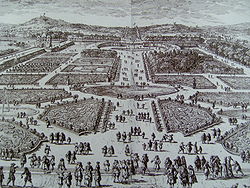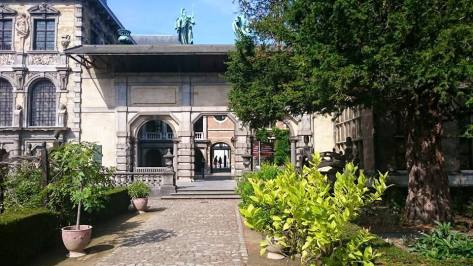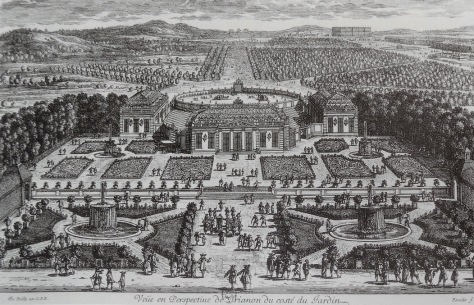
This week, I have been looking into what walking meant to Margaret Cavendish. I have tried to contextualize by considering what John Evelyn has to say about the subject in his diary and in one of his translations from the French. Evelyn was something of a Cavendish friend and certainly a leading authority on gardens. But why did people walk in gardens in the 17th century? Same as now or different?
Cavendish is quite modern in connecting walking to maintaining good health. Indeed, she is very specific in recommending walking for exercise, as this passage from Sociable Letters (Letter 130) makes clear.
“So the Lady V.R. when she is Sick, promises, if ever she Recover, she will Take the Air, and Use Exercises, but being Restored to Health, she Forgets her Promise, or only Looks out of a Window for Once or Twice, and Walks Two or Three turns in a Day in her Chamber, which is as little Exercise as she can do, the truth is, she Errs as much in living too much a Retired Life.”
This character sketch of the Lady V. R. is a parody by Cavendish of Cavendish. In her autobiographical excursus, “A True Relation” (found in Nature’s Pictures, 1656), Cavendish berates herself for neglecting her health and allowing her “lazy nature” to dominate. Her only exercise is “walking a slow pace in [her] chamber.” My sense is that Cavendish exaggerates her portrayal of herself as sedentary, but, whatever the case, she believes that walking induces to good health.

Cavendish writes in Letter 124 of Sociable Letters that her maids walked in the gardens of the Rubens House in Antwerp, where Cavendish lived with her husband for about ten years. The maids, she says, walked for their “health.”
John Evelyn’s diary is full of narratives of his walks along garden paths. He writes in detail about the elaborate terraces at St-Germain-en-Laye, which would have been known to Cavendish. He does not suggest that walking there or elsewhere involves exercise or is is good for one’s health. Unlike Cavendish, he uses the word “exercise” to indicate intellectual or religious activity. Walks are meant to bring one to beauty or to lead to a sort of garden drama. Of Cardinal Richelieu’s villa at Ruel, he says
“On one of these walks, within a square of tall trees, is a basilisk of copper, which, managed by the fountaineer, casts water near sixty feet high, and will of itself move round so swiftly, that one can hardly escape wetting.” (27 Feb 1644)
Cavendish notes such waterworks on occasion but is not especially impressed. We all know that nothing intrigued Cavendish more than scientific and medical questions, and she considers in a physiological way how walking can cause “rest and ease” in Letter 156.
“When any one Stands still, the Nerves and Sinews are Stretch’d straight out at Length, but when one Walks or Moves, they have Liberty, as being Unbent, and Unstretch’d.”
Her discussion continues at length and is worth reading if you are interested in knowing what Cavendish thinks happens in the body as a person walks.
Several of Cavendish’s female characters are found walking alone or are said to enjoy walking alone. Some of them are quite a bit like Cavendish in other ways, so is Cavendish telling us that she takes solitary walks? It is difficult to know for certain, but Evelyn may give us a hint.
“The rest of my time of stay at Wotton [the home of his childhood] was spent in walking about the grounds and goodly woods, where I have in my youth so often entertained my solitude.” (30 Aug 1681)
Late in life, Evelyn shifts from describing the the beauty and drama that he had searched for in gardens to reminiscing about other reasons for his walks. As a young man, he walked the “grounds and woods” at Wotton apparently to be alone with his thoughts. In a wonderful, if ambiguous phrase, he describes the situation by saying that solitude and entertainment go together in some way.
I would not be surprised to learn that Cavendish liked to walk alone in gardens and entertain herself with her musings. Indeed, many of us do that sort of walking today. Gardens, in any event, offer many possibilities. Because she was a member of Queen Henrietta Maria’s entourage, Cavendish would have walked with groups at gardens like the Tuileries (pictured at the beginning of this blog) or that found at the Trianon Porcelain (pictured at the end). There is pleasure in walking even in a vegetable garden, as Evelyn’s translation from the French of Jean de La Quintinie’s Complete Gardener (1693) makes clear.
“It is not sufficient to have set down in general, what relates to the Advantages of the Production [of food for the kitchen], we must likewise declare what relates to . . . the Pleasure of Walking.”
Cavendish frequently writes in her Poems (1653) of the pleasures of walking, but the thinking part can be work, too.
“When I did write this Booke, I took great paines,
For I did walke, and thinke, and breake my Braines.” (“The Claspe”)
A final suggestion. Let me know if you find Cavendish saying anything interesting about walking and gardens.

I was researching a folly in an old estate in The Neale, Co. Mayo, Ireland recently. The folly was an unfinished Temple, complete with 6 plain doric Columns ….. an article stated “The Temple was used by the ladies
of the Big House for family meetings, knitting and relaxing. In addition to relaxing at the Temple, the ladies also walked “The Cavendish Walks”, both inside and outside the estate.”
So did Margaret Cavendish’s ideas reach the wild and windy west of Ireland. This place, of which I speak, is about 3 miles from Ashford Castle, Cong, the hunting and fishing lodge of Lord Ardilaun, one of the famous Guinness brewing family.
LikeLike
Zara — I had a look in the online Oxford English Dictionary and did not come across “Cavendish Walk” as an architectural phrase. This identifier is likely to be found in the history of the house. Perhaps the great chemist Henry Cavendish, who discovered hydrogen, paid a visit. Henry was from the Dukes of Devonshire side of the Cavendish family. Margaret’s husband began the Dukes of Newcastle branch.
LikeLike